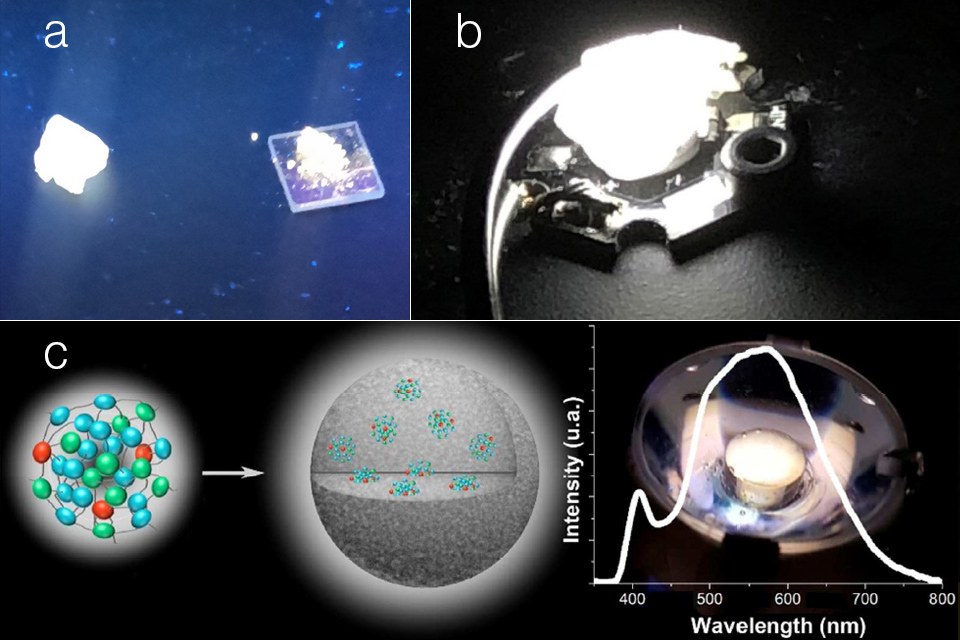Spanish Researchers Develop Sand that Produces White Sun-Like LEDs
The team led by the chemist-technologist Rubén Costa of IMDEA Materials (Madrid) and the chemists Jesús Berenguer of the University of La Rioja and Javier García of the University of Alicante has overcome one of the biggest obstacles in the progress towards new sources of healthier artificial lighting.
The high content of blue light presented by current LEDs can be harmful to the human retina, especially for children, and has a negative impact on our brain´s chemistry. Rubén Costa, researcher at the IMDEA Materials Institute of Madrid; Elena Lalinde and Jesús Berenguer, from the University of La Rioja, and Javier García, from the University of Alicante, have succeeded at producing a material similar to sand (silica nanoparticles) that emits high quality white light for a new generation of LEDs hybrids. The development of new silica nanoparticles that emit light is one of the most competitive fields and with more applications in the investigation of new sources of artificial light, since they reduce the impact on our visual system and can be manufactured in a more environmental-friendly way.
Within this field, university researchers from La Rioja and Alicante are experts in the use of coordination chemistry called sol-gel, a technique that allows the preparation of metal oxides with new properties. For his part, Rubén Costa, one of the international leaders in the design of luminescent devices, such as LEDs, and in the development of photovoltaic energy, investigates the properties of these oxides together with his research group in IMDEA Materials.
The fundamental contribution of this work is that it has managed to produce white light, which stands out for its stability, excellent quality and that does not harm the eyes. Until now, other researchers had managed to produce similar materials that emitted green, blue or red light, but not white, which is the key color for their future exploitation. In addition, the LEDs prepared with this new material present a record of stability that by far outmatches the previously developed monochromatic ones. The light emitted by these new LEDs is very similar to sunlight, which also makes it healthier. The practical interest of this white light emitting sand is that it could replace the current color filters based on rare earths such as Yttrium, whose extraction and exploitation causes significant negative effects on the environment.
Reference:
The work of this team of Spanish pioneers has been published by the magazine Materials Horizons, one of the most important international scientific journals in the field of new material applications. - pubs.rsc.org/en/content/articlelanding/2018/mh/c8mh00578h#!divAbstract
About Rubén Costa:
Rubén Costa (Valencia, 1983) is a chemist and research professor at the IMDEA Materials Institute in Madrid. He obtained his PhD in Molecular Science in 2010 from the University of Valencia and was Humbolt post-doc at the Erlangen-Nuremberg University in Germany where he investigated solar cells based on nanocarbons. Since 2013 he works with his own group in optoelectronics with hybrid materials. In 2017 he moved with his team to the IMDEA Materials Institute in Madrid. Despite his youth, Rubén Costa has received numerous awards such as the 2016 Young Researchers Award from the Royal Spanish Society of Chemistry; the Silver Medal European Young Award 2016; the European Innovator of 2017 or the Spanish Top Talent 2017 of the MIT Technology Review. Recently, Rubén Costa was the only Spaniard elected this year by the World Economic Forum as one of the thirty-six scientist’s champions under 40 years of age in the world.
About IMDEA Materials:
IMDEA Materials (Madrid Institute for Advanced Studies in Materials) is an independent research institute promoted by the Community of Madrid to carry out research in Materials Science and Engineering. The IMDEA Materials Institute belongs to the network of the Madrid Institutes of Advanced Studies (IMDEA).
The IMDEA Materials Institute currently has approximately one hundred researchers from sixteen different nationalities. His research activity is organized around five programs: Advanced Materials for Multifunctional Applications, New Generation of Composite Materials, Design, Processing and Development of Alloys, Computational Engineering of Materials and Multiscale Characterization of Materials and Processes. These research programs focus on the development of advanced materials mainly for the transport, energy, information technology and manufacturing sectors, as well as in the exploration of emerging materials and processes for sustainable development. - materials.imdea.org/

